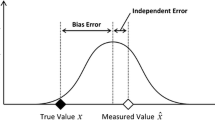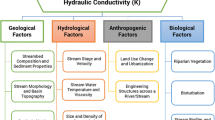Abstract
Six regional-scale flow models are compared to gain insight into how different representations of hydraulic-conductivity distributions affect model calibration and predictions. Deterministic geological models were used to define hydraulic-conductivity distributions in two steady-state flow models that were calibrated to heads and baseflow estimates using inverse techniques. Optimized hydraulic-conductivity estimates from the two models were used to calculate layer and model mean hydraulic-conductivity values. Despite differences in the two geological models, inverse calibration produced mean hydraulic-conductivity values for the entire model domain that are quite similar. The layer and model mean hydraulic-conductivity values were used to generate four additional flow models and forward runs were performed. All of the models adequately simulate the observed heads and total baseflow. The six flow models were used to predict the steady-state impact of a proposed well field, and the flow solutions were used in simulating particle tracking and solute transport. Results of the predictive simulations show that, for this example, simple models of heterogeneity produce capture zones similar to more complex models, but with very different travel times and breakthroughs. Inverse modeling combined with different geological models can provide a measure of capture zone and breakthrough reliability.
Résumé
Six modèles d'écoulement à l'échelle régionale sont comparés afin d'avoir un aperçu de la manière dont les différentes représentations de la distribution de la conductivité hydraulique affectent la calibration et les prédictions de modèles. Des modèles géologiques déterministes ont été utilisés pour définir les distributions de la conductivité hydraulique dans deux modèles d'écoulement en régime permanent qui ont été calibrés avec des estimations des charges et des écoulements de base faites par des techniques inverses. Les estimations optimisées de la conductivité hydraulique de ces deux modèles ont servi à calculer les valeurs de conductivité hydraulique moyenne des couches et du modèle. Malgré des différences entre les deux modèles géologiques, la calibration inverse a donné des valeurs de conductivité hydraulique moyenne pour le domaine complet du modèle qui sont complètement semblables. Les valeurs de la conductivité moyenne des couches et du modèle ont été utilisées pour générer quatre modèles d'écoulement supplémentaires et des traitements ont été effectués. Tous les modèles simulent correctement les charges observées et l'écoulement de base total. Les six modèles ont servi à prédire l'impact en régime permanent d'un champ captant projeté et les solutions d'écoulement ont été utilisées dans une simulation par suivi de particules et de transport de soluté. Les résultats de simulations prédictives montrent que, pour cet exemple, de simples modèles d'hétérogénéité fournissent des zones de capture semblables aux modèles plus complexes, mais pour des temps de parcours et des restitutions très différents. Une modélisation inverse combinée à différents modèles géologiques peut assurer une mesure de la zone de capture et une fiabilité de la restitution.
Resumen
Se compara seis modelos de flujo a escala regional para conocer cómo afecta a la calibración y a la predicción del modelo diversas representaciones de la distribución de la conductividad hidráulica. Se ha utilizado modelos geológicos deterministas para definir las distribuciones de la conductividad hidráulica en dos modelos de flujo permanente, calibrados mediante técnicas inversas con niveles piezométricos y estimaciones del flujo de base. Se ha adoptado estimaciones optimizadas de la conductividad hidráulica de los dos modelos para calcular las cotas de las capas y sus conductividades hidráulicas medias. A pesar de las diferencias entre ambos modelos geológicos, con la calibración inversa se obtiene valores similares de conductividad hidráulica en todo el dominio. Estos valores de las capas y de las conductividades hidráulicas medias han servido para generar cuatro modelos adicionales de flujo y realizar predicciones. Todos los modelos simulan de forma adecuada los niveles observados y los caudales de base. Los seis modelos han sido aplicados a la predicción del impacto estacionario de un campo de pozos, y las soluciones del flujo permiten simular el transporte de partículas y de solutos. Los resultados de estas predicciones muestran que, para este ejemplo, los modelos sencillos de la heterogeneidad dan lugar a zonas de captura similares a las generadas por modelos más complejos, pero aparecen grandes diferencias en los tiempos de tránsito y en las curvas de llegada. Una combinación de modelación inversa y de modelos geológicos diferentes puede proporcionar una medida de la fiabilidad de la zona de captura y de las curvas de llegada.










Similar content being viewed by others

References
Bair ES, Safreed CM, Stasny EA (1991) A Monte Carlo based approach for determining travel time-related capture zones of wells using convex hulls as confidence regions. Ground Water 36:849–855
Barth GR, Hill MC, Illangasekare TH, Rajaram H (2001) Predictive modeling of flow and transport in a two-dimensional intermediate-scale, heterogeneous porous medium. Water Resources Res 37:2503–2512
Bhatt K (1993) Uncertainty in wellhead protection area delineation due to uncertainty in aquifer parameter values. J Hydrol 149:1–8
Carrera J, Neuman S (1986) Estimation of aquifer parameters under transient and steady state conditions: 2. Uniqueness, stability and solution algorithms. Water Resources Res 22:211–227
Cole E, Silliman SE (2000) Utility of simple models for capture zone delineation in heterogeneous unconfined aquifers. Ground Water 38:665–672
Dybkjaer K, Rasmussen ES, Piasecki S (2001) Oligocene and Miocene stratigraphy in Vejle County (in Danish). Geol Surv Denmark Greenland Rep 2001/104
Evers S, Lerner DN (1998) How uncertain is our estimate of a wellhead protection zone? Ground Water 36:49–57
Feyen L, Beven KJ, De Smedt F, Freer J (2001) Stochastic capture zone delineation within the generalized likelihood uncertainty estimation methodology: conditioning on head observations. Water Resources Res 37:625–638
Henriksen HJ, Harrar W, Morthorst J, Nyegaard P, Dahl M (1995) Groundwater exploration for Esbjerg Waterworks Phase IV—Model (in Danish). Geol Surv Denmark Greenland Rep 51/1995
Hill MC (1998) Methods and guidelines for effective model calibration. US Geol Surv Water Resources Inv Rep 98-4005, Denver, Colorado, USA
Hill MC, Cooley RL, Pollock DW (1998) A controlled experiment in ground water flow model calibration. Ground Water 36:520–535
Klitten K, Morthorst J, Czako T, Henriksen HJ, Harrar WG (1995) Groundwater exploration for Esbjerg Waterworks Phase III (in Danish). Geol Surv Denmark Greenland Rep 25/1995
McDonald MG, Harbaugh AW (1989) A modular three-dimensional finite-difference ground-water flow model. US Geol Surv Open File Rep 83-875
Nilsson B, Sidle RC, Klint KE, Bøggild, CE, Broholm K (2001) Mass transport and scale-dependent hydraulic tests in a heterogeneous glacial till-sandy aquifer system. J Hydrol 243:162–179
Poeter EP, Hill MC (1998) Documentation of UCODE: a computer code for universal inverse modelling. US Geol Surv Water Resources Inv Rep 98-4080, Denver, Colorado, USA
Pollock DW (1989) Documentation of computer programs to compute and display pathlines using results from the U.S. Geological Survey modular three dimensional finite difference ground-water flow model. US Geol Surv Open File Rep 89-381
Rayne TW, Bradbury KR, Muldoon MA (2001) Delineation of capture zones for municipal wells in fractured dolomite, Sturgeon Bay, Wisconsin USA. Hydrogeol J 9:432–450
Ritzi RW, Jayne DF, Zahradnik AJ, Field AA, Fogg GE (1994) Geostatistical modeling of heterogeneity in glaciofluvial, buried-valley aquifers. Ground Water 32:666–674
Springer AE, Bair ES (1992) Comparison of methods used to delineate capture zones of wells. 2. Stratified-drift buried-valley aquifer. Ground Water 30:908–917
Stockmarr J (ed) (2001) Groundwater monitoring report (in Danish). Geol Surv Denmark Greenland Rep 87-7871-096-0
Sun N-Z, Yeh WW-G (1985) Identification of parameter structure in groundwater inverse problem. Water Resources Res 21:869–883
van Leeuwen M, Butler AP, Stroet CBMT, Tompkins JA (2000) Stochastic determination of well capture zones conditioned on regular grids of transmissivity measurements. Water Resources Res 36:949–957
Varljen MD, Shafer JM (1991) Assessment of uncertainty in time-related capture zones using conditional simulation of hydraulic conductivity. Ground Water 29:737–748
Vassolo S, Kinzelbach W, Schäfer W (1998) Determination of well head protection zone by stochastic inverse modelling. J Hydrol 206:268–280
Zheng CM (1998) A modular three-dimensional multispecies transport (MT3DMS) model, release DoD_3.00.A. Waterw Exp Stn US Army Corps Eng, Vicksburg, Miss
Acknowledgements
This study was conducted as part of the project entitled "National Water Resources Model" that was cooperatively funded by the Danish Environmental Ministry and the Geological Survey of Denmark and Greenland. We appreciate the comments and suggestions of John Barker, Jens Christian Refsgaard, and two anonymous reviewers. The authors thank Mette Dahl for assistance in analyzing the baseflow data, and Per Nygaard, Jørn Morthurst, and Bente Mörch for assistance with the geological models. We are also grateful to Kristian Rasmussen for preparing the technical illustrations.
Author information
Authors and Affiliations
Corresponding author
Rights and permissions
About this article
Cite this article
Harrar, W.G., Sonnenborg, T.O. & Henriksen, H.J. Capture zone, travel time, and solute-transport predictions using inverse modeling and different geological models. Hydrogeology Journal 11, 536–548 (2003). https://doi.org/10.1007/s10040-003-0276-2
Received:
Accepted:
Published:
Issue Date:
DOI: https://doi.org/10.1007/s10040-003-0276-2



